Think about the really stereotypical service pistol for the 21st century (so far) – it would be something with a polymer frame, large magazine capacity, minimum of manual controls, and a striker with a safety built into the trigger pull. Like a Glock or Springfield XD or Smith and Wesson M&P. Everyone in tune with the times seems to have come to an agreement that this is the ideal set of features for a “serious” service sidearm. Now think back to the 80s (having been born in the 80s, I’m judging the second-hand, but bear with me). What features were really desirable on service sidearms back then? Large caliber, manual safety, and stainless steel (and lots of it), right? In that case, I present a quintessential 1980s combat pistol:
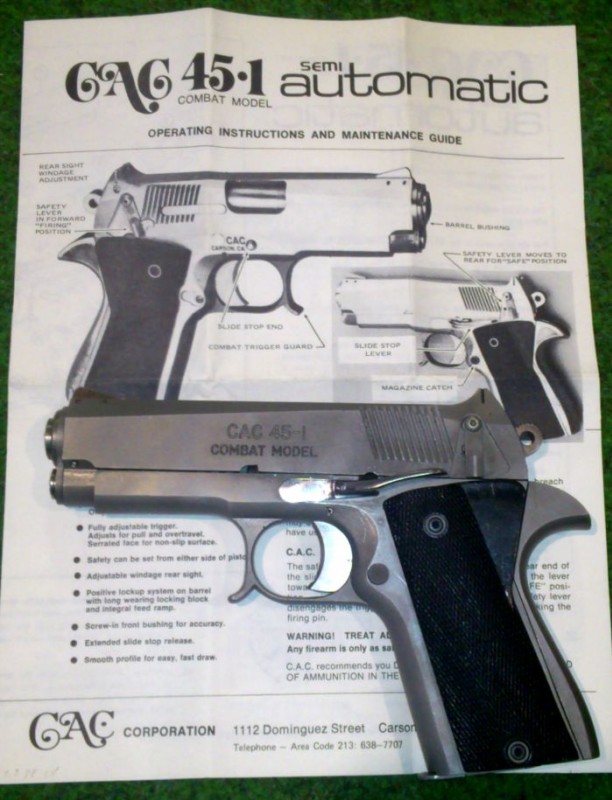
This is the Combat Model .45, made by a company called CAC for Mossberg. It was designed by none other than Bo Clerke (of barrelmaking notoriety, as well as the .38/.45) first shown to the public at the 1979 SHOT Show. Mechanically, it is basically a 1911, with design changes made to address what were considered shortcomings in Browning’s venerable pistol. The differences are:
- No grip safety. Instead, it has a huge beavertail to protect the shooter’s hand from the hammer.
- Rear sight adjustable for windage by a small screw.
- Massively extended slide release, which can be operated by the shooting thumb.
- Safety (ambidextrous) mounted on the slide; push forward to disengage.
- Cam slot in the barrel (like the High Power) instead of Browning’s swinging link.
- Threaded-in barrel bushing, theoretically for improved accuracy.
- Full-length guide rod for the recoil spring.
- External extractor.
- Shortened 4 inch barrel.
- Pivoting trigger rather than Colt’s yoke type.
- Beveled magazine well.
- And, of course, the entire gun is made of stainless steel (all 36 ounces of it).
As you can see, many of these updates are not exactly original to this particular pistol. My Ballester-Molina incorporates several, as does the High Power (which was Browning’s follow up to the 1911, although he died before completing it). A couple anachronisms are also evident, primarily the “combat” style trigger guard spur. To quote Dr. Ralph Glaze’s article on the CAC .45 in the 1979 Guns & Ammo Annual:
Since “Combat” shooting requires the use of a two-hand hold, it has long been common practice to “square-off’ the front of the trigger guard on combat autos to· provide a steady rest for the forefinger of the non-shooting hand. The Mossberg Combat .45 not only has a square trigger guard, but also has a small hook at the bottom front of the guard to keep the finger from sliding down as a result of motion induced by recoil during rapid fire . It’s a small thing, but that little hook really works in helping to maintain a solid two-handhold.
Not exactly today’s style, eh?
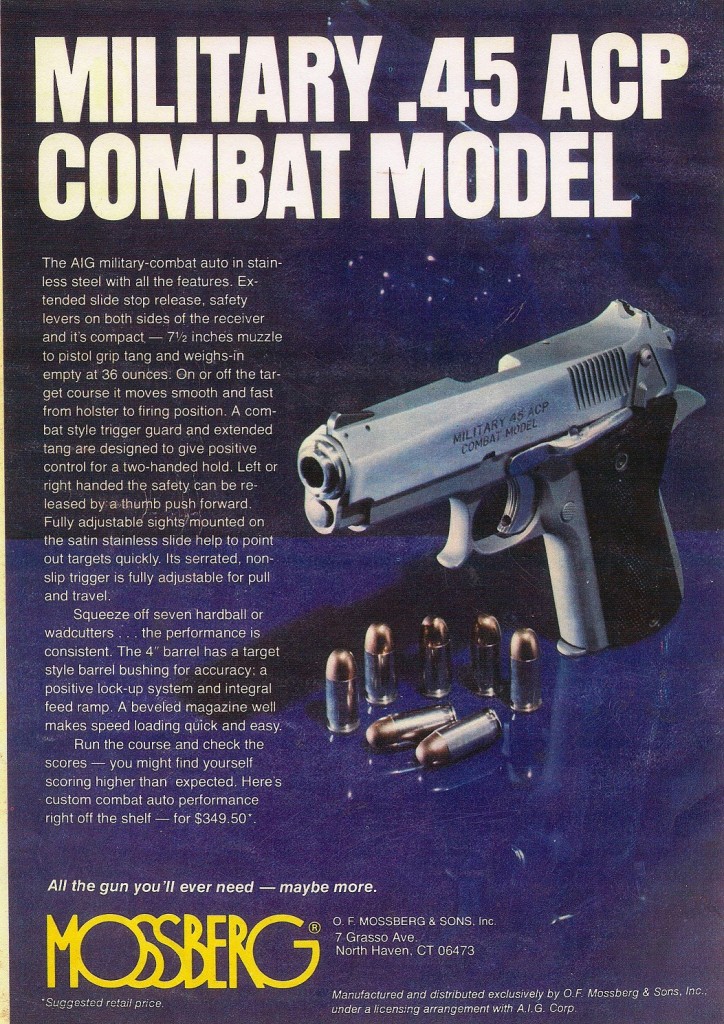
Since that list above of changes form the 1911 looks pretty long, we should point out the elements that were kept the same. Primarily it’s the operating mechanism. The Mossberg gun is a recoil-operated, short recoil system identical in principle to the 1911. As recoil pushes the slide backwards, the barrel is cammed downward at the chamber end, disengaging the two locking lugs from the top of the slide. The disassembly is identical in principle, with just changes to the details from the extra screwed-in bits. The magazines are also interchangeable, at least on some of them. Reportedly some were designed for a magazine with the mag catch cutout slightly higher than the 1911 standard, but some were also made to use stock 1911 mags. The standard, though, was just 6 rounds – a regular 1911 mag will stick out below the bottom of the grip.
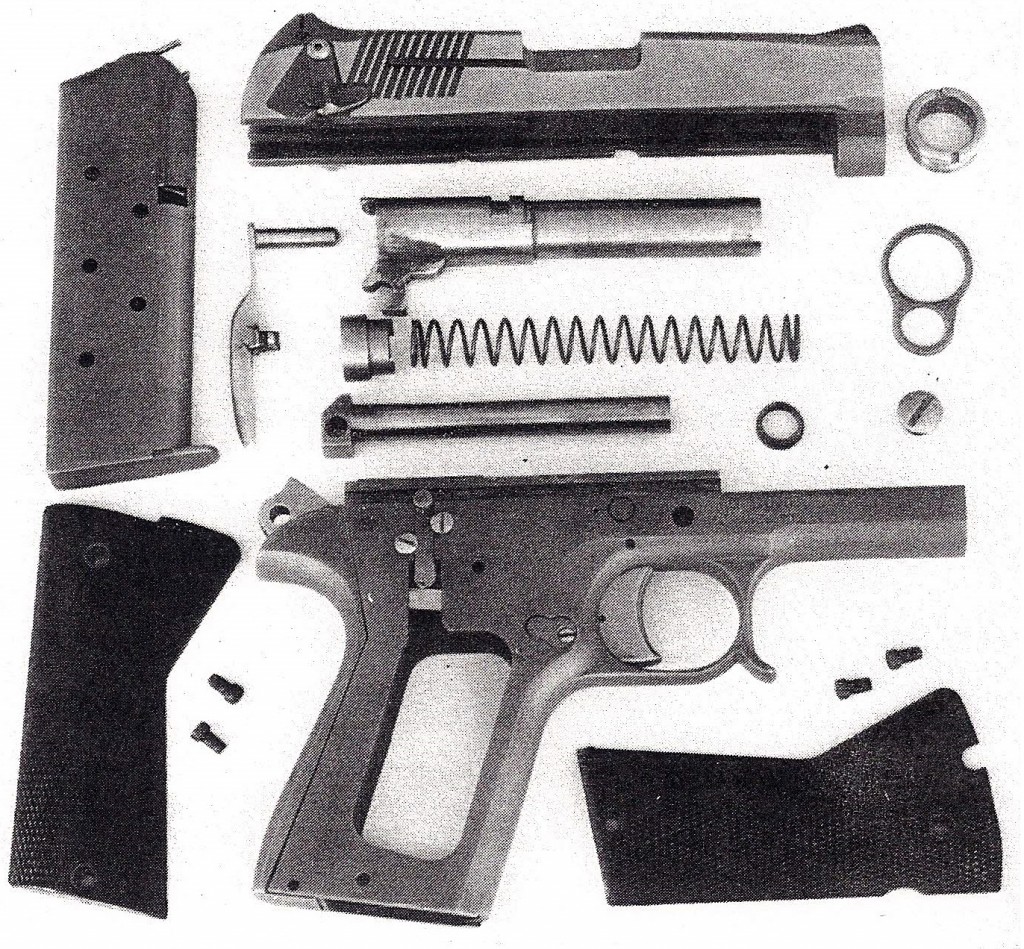
Mossberg planned to release the gun to commercial public sale (they went so far as to print instructions and advertising), as well as submit them to the Army for testing in the hopes of getting a contract to replace the 1911. Somewhere along the line it all went wrong, though, because only a handful were ever actually made (and the Army apparently wasn’t interested). I had the chance to inspect gun #1127, seen a writeup on #1025 (with great photos), found an auction sale of #1105, and seen photos of #1145. That suggests that serial numbers started at 1000, and something like 150 were made in total. Why the gun died on the vine so abruptly, I do not know…it could be anything from industry intrigue to a simply underestimation of production cost and market interest.
Technical Specs
Caliber: .45 ACP
Magazine capacity: 6+1 (some can use standard 1911 magazines)
Barrel length: 4 in (102mm)
Overall length: 7.5 in (191mm)
Weight (unloaded): 36 oz (1020g)
Action: Short recoil
Locking system: Tilting barrel
Material: Stainless steel
Photos
Here are some photos of CAC .45 number 1127 (thanks to reader Bob for letting me examine it). This example is missing its safety lever:

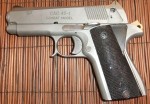
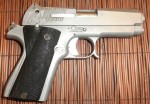
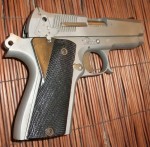



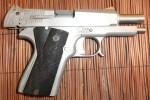




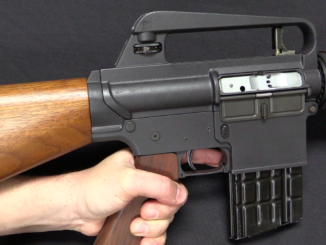
How does the $350 MSRP compare to contemporary 1911? The gun might have died due to the old dilemma: We can make a great gun that no one can afford or an affordable gun that no one wants to buy.
According to an inflation calculator, this pistol’s MSRP is about 1,000 USD.
IIRC a Colt Government model in the mid 80s was about £200 in Britain.
That said, it was a time of double digit annual retail price inflation in Britain and America, With Thatcher and Reagan both doing massive stop start printing of paper currency.
The fluctuations in money printing rate resulted in £1 sterling buying from around $1.50 to around $4.00 US.
That stop start money printing also correspondingly resulted in a series of business cycles, with massive new investments being mistakenly begun during the low interest inflationary stage, only for them to have to be liquidated as soon as the money printing slowed and interest rates increased, revealing the mistake.
That process killed off much of British and American manufacturing.
The reduction of standard magazine capacity to 6 cartridges was a very strange choice, if the goal was to make a modernized M1911. Of course this was in the late 1970s when the six shot capacity of a revolver was still considered sufficient, especially in the US, but still it appears a poor choice.
It looks like they were trying to create a concealed carry pistol. There wasn’t much in the way of small .45 ACP pistols in those days. You either bought a Detonics or had a pistolsmith build a Bobcat conversion from your existing Government Model or Commander.
In the 80’s you could also get the AMT .45 backup which the early versions, once tuned, I still consider the best of the small .45s. Only six shots but can be covered by the area of my hand.
At that time, the OMC/AMT Backup was only chambered for .380 ACP. The larger .45 ACP model did not show up until the mid-1990s.
Thanks Daniel, I did not know that. I thought they all came about the same time.
Just saw they were introduced in the April 1995 edition of American Rifleman, apparently MSRP was $400. These days the go for about $250.
Six isn’t good for an automatic is it, in that a revolver holds six.
This was six in the magazine, plus one in the chamber. Moreover, where would you find a .45 ACP revolver that small and light back then without significant pistolsmithing?
Military guns don’t require concealment though, it has military stamped on the side.
They don’t require concealment, but sometimes it is handy to have a smaller pistol for aircraft/vehicle crews. You also have the real life examples of the compact M15 General Officer Pistol and the USAF’s custom OSI pistol. Truthfully, I think the Military label was a bit delusional. What military was looking for a new .45 ACP pistol in the late 1970s?
Aye I suppose given Nato used 9mm…
I assume its about as “MILITARY” as spyderco paratrooper is paratrooper’s knife.
Can you carry a 1911 then with a round in the chamber Daniel, news to me, can you lower the hammer manually in a safe manner then?
Single action aren’t they… Do you mean with the safety on? Don’t fancy that, particularly.
Although there’s the grip safety, also… If you dropped it through and it landed on the hammer, could it go off? I think that’s the idea behind Glocks i.e. they wouldn’t go off.
Might not be a bad idea that actually, still… I think they should make Military ones with steel lower frames, for clubbing.
Their advertisement clearly anticipated the user carrying a round in the chamber. Given that the safety only appears to disengage the trigger bar via the disconnector, it probably isn’t wise.
At the time this was being offered, I bought my Auto-Ordanance 1911A1 for $300.00. Larger magazine capacity, longer barrel, lower cost. It may have been a nice pistol, but I don’t like its looks. mikey
O.F. Mossberg’s Directors determined that it was not in the company’s best interest to produce handguns due to the political environment at the time. The same decision killed off a single shot pistol design that Mossberg was considering for production. This was consistent with their decision to kill the ‘Brownie’ pepperbox 50 years earlier.
Trigger mechanism on this pistol and the extractor design look like they were lifted from the Star Model A. You could come up with a much worse design to copy.
I was thinking it looks like a Star PD.
I’ll bet trying to find a holster that would fit the Mossberg due to the hook on the trigger guard would have been fun. I bought a Colt “update to the 1911 about during those years. I believe it was called the Double Eagle, or something like that. It was a double action pistol designed, I suppose, to “fix” perceived issues with the 1911, or at least to “modernize” it. Soon after trying it I it found a new home and I went back to my “outdated” 1911.
So will a 6 round Officers Model 1911 mag fit flush? Colt didn’t introduce a commercial Officers Model until 1985 though. This would have been a competitor to a Detonics Comnbat Master at a much cheaper price point. This was probably close to the MSRP of a S&W L-Frame in the 1980s. I would have to go back and check old Gun Digests or Guns and Ammo Annuals.
That’s an excellent question. If I remember correctly, the early MS Safari Arms Enforcers have a compact frame that does not quite match up with the Colt OACP.
I’d forgotten about Safari Arms, with it’s lump on the front of the grip, one finger’s width below the trigger guard.
Britains military have just replaced the Browning “Hi-power” with the Glock, I thought a Cz75 bd would have been more apt personally given it resembles the Browning more and the metal pistol grip is surely better for use as a club.
I like the .45acp round on the face of it, para ordinance did a 14 round .45 1911 I like that. It’s easy to silence, and well I just like it… It’s wider, slightly more chance of it hitting things in a smg. And well, in a short case and big bullet might provide the power lacking in the charge sort of thing. They are supposed to have good stopping power etc.
That Para ordinance would make a good club, good grip, metal etc.
A de-cocking feature is handy, with double action, which the Browning lacked.
But it would have been a decent club.
While I love CZs, they’re great handguns and I have several of them, I would not like to imagine the 75 as a military sidearm. I just detail stripped a pre-b 75 this week, which should be less complicated than the newer models. It still had over 60 individual parts, including a number of tiny springs and pins which love to shoot off into the carper/grass when disassembled. It made detail stripping the 1911 look like the height of simplicity, hell it made stripping the C96 seem effortless.
Oh right, well i’ve never handled one Ian. So I will take your word for it 🙂 On the face of it, it looked apt… In that it was sort of like the Browning but with extra useful features. Mind you extra features presumably need more parts, didn’t think of that. The Sig 226 has a de-cocker etc and that’s a military gun, is that more or less complicated than the Cz in your opinion out of interest? I’ve played around with a blank Sig in Germany, took it apart couldn’t put it back together actually “stripped” right down, wee springs etc, binned it.
Yes, I would say the Sig P226 is less complicated than the CZ 75. It has fewer parts and they are less “fiddly”. Sig may also have the edge in internal finish quality. That said, I prefer the ergonomics and shooting characteristics of the CZ much more.
As far as the British replacing the Hi Power with the Glock. I never have found much to like about Glocks besides their simplicity and ease of use. I understand the Hi Powers were getting very worn out however, still I think the old design has some life left in it yet. I know my older hi powers did have the occasional trouble with reliability, if the newer ones have fixed that, I would have just bought some of them instead. Of course they would probably have been more expensive.
There was a short series in Jan Stevenson’s “Handgunner” in the early eighties which advised (from bitter experience) that if you really must fully dis-assembe a CZ 75, to do it inside a big clear plastic bag.
Does anyone know if Jan Stevenson is still with us? I haven’t heard of him since he got seriously injured by a car that ran off the road and hit him, and the British Government closed Handgunner down for several months after he published an article listing the faults of that piece of sh!te, the SA80. That must be over 20 years ago now.
Come to that, does anyone know if pioneer student of British gun controls, and long time editor of “Guns Review” Colin Greenwood still with us?
One of Thatcher’s former cabinet ministers bought the magazine’s publisher, fired Greenwood, and closed the magazine down, ahead of the 1997 General Election. in order to silence dissent over the handgun ban.
Google is a wonderful thing: http://www.tandgmagazine.com/comment/colin-greenwood
Although his latest column appears to be nearly a year old.
Re: the recent British pistol purchase – From what I understand of the situation Britain set the criteria for a new pistol, asked for proposals, evaluated them, and then picked the cheapest one that ticked all the boxes.
The British also had SIGs to supplement their BHPs, as the older BHPs (I have heard that some are WW2 Inglis models) are pretty worn out after a very long service life. The Glock is the overall replacement.
Most armies don’t consider pistols to be very important from an operational standpoint, so they’re not too fussed over what pistol they buy so long as it goes bang when they pull the trigger.
They do use Sigs now apparently, here and there. I never saw one years ago, well awhile ago. Oh aye, they’ll have been “cheaper” that’s for sure, maintenance contracts etc better prostitutes to sweeten the deal than Colt or whoever.
Curious in the print ad how they specifically talk about hardball and wadcutter but not HP. I’m trying to recall 1) what HPs were on the market and 2) how “accepted” were they, both in performance and perception. Interesting how a reduced single-stack 45 played against the Wonder 9s of the time.
I believe the wadcutter comment is a reference to its omnivorous nature and lack of sensitivity to varying power levels. The factory .45 ACP mid-range wadcutter loads were notorious for tying up the standard M1911 and Government Model pistols of that era. The lower velocity and short noses of the 185gr softball loads were not always compatible with the narrow barrel throat and heavy springs designed for 230gr hardball.
There was not much in the way of .45 ACP hollowpoints. Super Vel availability was hit or miss. The Remington 185gr JHP was probably the most reliable, but didn’t necessarily expand. It might have been too early for the Winchester Silvertip in .45 ACP. The old Norma 230gr JHP had a steel jacket, and again, its availability was probably spotty by then.
Did some more digging and found that .45 ACP Silvertip should have started hitting the market in 1979. I’m not certain when CCI-Speer introduced their 200gr JHP, which the late Dean Grennell dubbed the “Flying Ashtray.” The large cavity that inspired its nickname, combined with the short loaded OAL, gave a lot of unmodified pistols grief. You’ll note that a lot of old gunzine reviews of .45 ACP pistols would break out the CCI-Speer 200gr JHP and any of the factory 185gr SWC mid-range loads when they wanted to see if they could make their test pistol choke.
Not a great name either, cac. Cack, pronounced the same ie Kak. In English, English means excrement, rubbish etc.
Yes, I had the same thought 🙂
i dont think it sold because it looks like someone made it in their garage. That large piece on the top of the grip looks like they were too lazy to make their own grips so they just glued that onto a 1911 grip. Also the slide release is nothing more than the thumb safety from a 1911 they re-purposed for a slide release. The entire gun looks very haphazardly thrown together. I wouldn’t have wanted it either.
It’s neat to see stuff like this from the gun rags of my youth. I love military guns a lot, but in the military, many of the more outlandish ideas are filtered out by both practicality and resistance to change. Civilians are much more… interesting… in their choices.
I hope we get to more 70s and 80s interestingness.
Sheesh, I’m old enough to remember when this thing came out. It was designed to rectify all of the complaints about the 1911 that were being altered by custom builders such as Pachmayr, Swenson, Clark, etc. such as pinned grip safeties, beavertails, squared off trigger guards (for the old “wraparound two-hand grip with the left index finger resting on the front of the trigger guard” … hey, that was state-of-the-art technique back then when I was shooting my Clark Custom Colt Commander or the C4 as I called it). Also, prevailing “wisdom” back then (according to Col. Jeff Cooper) was that the 9mm was an ineffective cartridge, hollowpoints of any type were unreliable and prone to causing jams, and the line was “They all fall to hard ball.” Times and techniques have changed, but I wonder what the future holds, since this was “the future” back then. Now I feel like a dinosaur. But I still have that Colt, and it still runs like a champ.
Safety lever so located that being a candidate to act like a pendulum back and forth during reciprocal movement throagh inertia. Locking lugs over the barrel might be deleted for the sake of a ejecttion port propped up type
which was popular at that time.
I’ve never been able to figure out why Mossberg put that odd safety up on the slide. Not only is it hard to reach with your thumb (like most Walther-type “hammer drop” safeties), it works at 90 degrees to the pivot axis of every other slide-mounted safety out there.
I dislike “slide” safeties on general principles, having dealt with them on Walthers, Berettas, Makarovs, clones of all of the above, and the most reprehensible of them all, the Desert Eagle. The only practical way to operate that behemoth’s safety is with the thumb of your “off” hand in the two-hand grip. Frankly, thumb-cocking it on the way up is faster, easier, and more certain. The early rounded safety is easily missed in the draw, and the later “adze” safety tends to draw blood.
The CAC safety looks like a Sig P-210 safety turned 90 degrees and transplanted to the slide, or the Tokagypt 58 safety turned upside-down and moved from the frame to the slide. Both those safeties were miserable to begin with, and I see no advantage in copying them.
As for “compact carry” .45s, I’ve always found it interesting that by the time custom smiths, and later manufacturers, got done “chopping and channeling” 1911s, what they usually ended up with was a pistol the size and weight of a standard-issue P-35 High Power. If that’s what is desired, I’d rather stick with the full-grown HP, which I know will work and has 13 + 1 rounds of 9x19mm on tap. And FTR, mine has a WW2-style burr hammer, not that fanged monster that rips your hand with every shot.
cheers
eon
That slide safety is an abomination, but overall, that pistol represents the distillation of ’80s “combat pistol philosophy” in the US. To this day, there are those who dismiss the 9mm as being ineffective, although none of the naysayers will volunteer to be shot with one! Also, the variety of modern defensive ammunition makes the caliber debate rather moot in this day and age. However, the 80’s were a different era. Men like Col. Cooper and Elmer Keith were the “pistol gurus” at the time, and both espoused the “bigger is better” philosophy which, at the time, made sense considering that FMJ ammo was all that could be considered reliable in an autoloader. The 9mm was said to “overpenetrate,” while the .45 in its 230 grain FMJ configuration was touted as a “proven manstopper.” I’ll have to admit that I was swayed by this philosophy at the time, although personally, I have always been very fond of the Hi-Power (I have over a dozen of them in various incarnations, including Argentine, Israeli, Belgian, Nazi, Inglis, a GP Comp., and a Renaissance.) Still, the .45 Commander was my EDC for about 20 years, alng with a 2″ S&W Model 66 in .357 Magnum (with 125 grain SJHPs…a real “manstopper!”) The Hi-Powers were collectibles and range pistols. With advances in ammunition types, I have re-evaluated my stance regarding the 9mm as a defensive round. What I find most amazing about this whole subject is how easily myth and “expert” opinion shape the prevailing philosophy with regards to firearms design and popularity within the shooting community, particularly with regards to “combat” handguns. This Mossberg .45 is truly a product of its generation.
Regarding Col. Cooper’s philosophy, I’d say it was one of try it and see what happens. To see what would work he put together realistic matches where competitors could try out different weapons and tactics. That worked well for identifying the elements of modern pistol shooting (two handed hold to control recoil for follow up shots, aimed fire, etc.) and those elements were not what he initially suspected would work. There is a classic picture of Cooper shooting a revolver in a 1960’s era “gun man’s crouch” in competition against Jack Weaver who was holding his gun with both hands and using the sights. Weaver cleaned up the match, so Jeff started doing what Jack did, and gave him credit for it. The purpose of early practical competitions was not just so that one could improve one’s skills, it was really more about people figuring out for the first time what really worked.
The one area that has to remain somewhat theoretical is terminal ballistics as there is no try it and see. Given that there are two approaches: case histories (i.e., antidotal accounts) and quantitative approaches (try to correlate measurements to effects and then extrapolate or at least rank). The anecdotal history of large and small bore goes back to the Indian fighting out west pre-Civil war: 36 and 44 caliber percussion revolvers were made and the 44 caliber ones had a better reputation. That held true in the Philippines insurrection and in WWI (e.g., McBride’s accounts of the WWI pistols in actual combat). Early attempts at quantifying stopping power, e.g., Hatcher’s formula, suggested big was better. That was what Cooper had to work with in his prime. And when high velocity hollow points were in their infancy, he was not blindly going with the bigger the better, he was being rational. In a video I’ve seen of a talk on terminal ballistics that he gave in the mid 1980’s he went over energy, velocity, bullet shape, etc. He knew the arguments pro and con (small and fast vs big and slow), but what he came down to in the end was why hope that a small bullet expands to the same diameter that a large bullets starts off at? We are today in a later generation of hollow point designs that did not exist then.
Regarding the gun itself, it looks like it used Offer’s Model magazines. And on magazine capacity, I doubt that Mossberg saw the High Power or the CZ-75 as the competition, but more likely saw the S&W 39 as the competition. The S&W only had 8 rounds of 9mm, and otherwise is sort of similar looking to this gun. The big difference being the S&W was double action and this one was single.
As I understand it, when the British Army went into Iraq/Afghanistan there was a desire to provide more pistols to NCO’s as well as officers. Most of the Brownings were fairly old and in a poor state, my brother was in the RNR in the 80’s-90’s and the standing order at the time was that after firing they had to be checked by a qualified armourer which is why they used Sterling and L1A1’s for boarding duties until the L85 was issued as a replacement.
The Sigs were bought on the basis of a Urgent Operational Requirement (UOR) and issued as required, they were never intended to be an “issue” weapon and didn’t go through the full process to be accepted as such. In the mean time the MOD started to look into replacing the Brownings in service and went through a full trials and selection process which led to the selection of the Glock. As I understand it, there were problems with the Sigs including (allegedly) a couple developed cracked slides after relatively low number of rounds and there were problems with spares. From what I have read on a few boards the Sigs are being phased out and will probably be disposed of in the form of aid to another military somewhere.
Personal I think everyone should get a .455 Webley with a Pritchard bayonet to close with the enemy, they just do not like it up em.
Has anyone else ever seen or own a CAC- Mossberg 45 If so what was the serial #???
quite like the look of the Savage .45 in that it resembles a .22 Ruger “the Nambu, looking one” in away, and thus a Luger sort of.
I’ve been thinking about a kind of version of it, if you take the bolt design off the Ruger pistol, but imagine it has a thumb/finger toggle grip thing “like off a Luger” popping out the back of it. This would be attached to a pivoting bar, which would drop out of the bottom of the bolt aforesaid. Imagine the slide of the Savage being inside a sleeve, attached to which are the sights. The slide would have a semi circular cut out in the rear of its lower, for the toggle grip to fit inside. And the sleeve would have a cut out to allow the sleeve with the toggle grip in it, to fit inside it. Now the barrel would have a lug on it behind which, would be a return spring. The front of the lug would be encapsulated by the front of the slide, and in front of the spring would be a stop for it in the frame. So you would grip the toggle thing and pull the bolt and thus slide/barrel rearward, after about “a bit longer than a complete .45acp cartridge” the toggle thing would pass the end of the frame so it would drop out of the slide enough to clear the cut out for it. At which point, the trigger sear would catch on a notch in the underside of the slide. The bolt would have a floating firing pin, and would have it’s own spring like the Ruger only it’s stop would be a part of the slide not the frame. The “toggle” grip thing would only drop low enough to clear the slides cut out, and below this would be a hand guard i.e. a spur off the pistol grip. The bolt is now unlocked from the slide/barrel, so you can pull it further to the rear separately from the slide. The slide is therefore the striker in conjunction with the fixed firing pin on the bolt, the magazine is in line with a cut out on the underside of the slide in this it’s rearmost position i.e. aligned with the breech. So to charge you operate the bolt, by pulling it rearward and letting go. When you pull the trigger the sear releases the slide, the bolt being inside it moves with it which pushes the “toggle” into the slide locking the bolt via it now be encased by the slide and over the frame so it can’t fall out “the pivoting bar, would be sprung loaded so as not to rely on gravity” the slide in it’s fully forward position means the pin has activated the cartridges primer, so it’s fired. When the slide recoils the barrel moves with it until the sear catches it, when it does it’s at the point were the “toggle” disengages from the slide, the bolt then carries on rearwards ejecting the empty via a static firing pin passing through it which is attached to the slides rear. The bolt is then returned by it’s own spring, were it returns to the position which at this point is behind a new round contained in a 14rd Para Ordinance 1911 mag. Pulling the trigger, releases the slide so the bolt picks up a round, and repeats. The safety is that the firing pin is like the Orita M1941 SMG “on this website” but upside down, in that when you pull the trigger the sear depresses and releases the slide/striker, but it’s rear rises and the pin smacks into that and thus tilts to hit the cartridge “if the trigger wasn’t pulled said rear wouldn’t be up so if you dropped it, it wouldn’t go off” point being the sights are fixed for accuracy, and the lack of slide movement should help prevent rearward movement and it would be a good club.
What y’all think? Want a picture 🙂
Upwards, rearward movement sort… Er, muzzle flip.
It would have a heel grip mag release, for simplicity.
Overall it wants to resemble a “fat”
http://www.ruger.com/products/2245Target/models.html
think it would work?
All nice and blued, polished he he…
oooh, it could have a bayonet lug. 14rnds .45, be like get some, get some, BAM! BAM! KA-POW! Then JAB! JAB!! Take that Gerry, who won WW1.
I think it would work, make one if you like and see.
I can’t it’s impractical, living in the U.K
Not very modern, but it would look goooood.
Might not even work, anyhoo have fun Yankee peeps.
?
Sorry I was drunk, watching world cup soccer. Went off on a bit of a tangent there… Ahem, cough. Anyway, here is a link to my photobucket album were there’s a basic illustration of what I was saying.
http://i1142.photobucket.com/albums/n607/patrickmurphy3/UNI.png
The bolt is in blue “think the Ruger” the slide is red, and the sleeve/frame green. Upon firing the slide containing the bolt move back with the barrel, until the cocking toggle thing is free of the slide. At that point it works like a Luger, and then as described previously in theory.
Just saying a .45 Ruger would be nice that looks like the one in .22
THE LIKELY REASON FOR THE FAILURE OF THE CAC. I own a CAC “Combat Auto” marked made in Carson California. I study firearms very carefully and found the following 2 fatal flaws:
1.) The safety is intended to retract the firing pin inside the firing pin well. The left side safety includes a “wing” that engages a rivet attached to the (“Star style”) disconnector. On my pistol the rivet had fallen off. This missing rivet would allow the trigger to be pulled releasing the hammer (with the safety engaged).
2.) I noticed that the firing would still protrude from the slide a little when in the “Safe” retracted position.
Since the safety does not lock the slide I decided to test fire the pistol with the safety engaged (in my firearms testing tube). The pistol would fire. Thus the combination of 1.)Poor design using a cheap rivet to perform an important safety function and 2.)Poor quality control allowing over length firing pin, combine to make a very dangerous pistol that could fire with the safety ON.
Shortening of the firing pin and welding and finishing on an area at the top of the disconnector to engage the wing on the safety solved the issue making my pistol perfectly safe. The pistol works very well. I believe the only parts that are inter-changeable with the 1911 are the hammer, the magazine catch and the magazine (also the slide stop with some gunsmithing).
1974 Gun Digest listed the CAC pistol prior to the company being acquired by AIG/Mossberg in (I believe) the late 1970s(they also acquired Abaline SA revolvers). It is my belief that AIG/Mossberg learned of the flaws and decided not to produce the CAC. AIG/Mossberg did produce some Abaline revolvers (early 1980s) that did not meet the previous standards of Abaline quality and they were dropped from manufacture.
Does anyone have a CAC 45-1 that they would like to sell? I would be interested! You can call me at 507-227-3448 or e-mail me at steve_eernisse@hotmail.com.